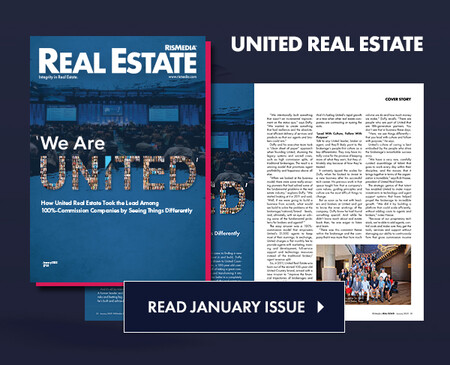New data suggests the U.S. housing market hit a turning point in its supply struggle in May, as active inventory recorded the first year-over-year increase since June 2019, according to the latest realtor.com®’s Monthly Housing Trends Report released this week.
At the same time, the median national home price soared to an all-time high of $447,000 and buyers snatched up listings a week faster than last year, the report stated.
Key findings:
- Nationally, the number of active listings increased 8.0% year-over-year in May, but remained 48.5% below typical levels in May 2020 at the onset of COVID.
- Compared to last month’s year-over-year changes, May’s national data showed a significant improvement in the new listings trend (+6.3% vs. 1.3%) and a bigger decline in pending listings (-12.6% vs. -8.7%).
- Among May’s new listings, the share of smaller homes (up to 1750 square feet) declined year-over-year (to 45.7% from 47.3%), while those with 1,750-plus square feet increased from 52.7% to 54.3%.
- On average in the 50 largest U.S. markets, active inventory grew by double-digits (+14.9%) over May 2021 levels, with the biggest increases in the West (+33.6%) and South (+18.3%), led by Austin, Texas (+85.8%), Phoenix (+67.1%) and Sacramento, Calif. (+54.6%). Active listings declined on a year-over-year basis in just 8 markets.
- Thirty markets posted annual gains in newly-listed homes, with the biggest increases registered in southern metros: Raleigh, N.C. (+27.9%), Nashville, Tenn. (+22.8%), and Las Vegas (+20.7%).
- The U.S. median listing price hit an all-time high of $447,000 in May, rising at a faster year-over-year pace (+17.6%) than last month (+14.2%). On a square foot basis, asking prices for active listings increased 16.2% over May 2021 levels.
- In a potential sign of softening buyer demand at the national level, the median listing price of a typical pending listing actually decelerated in May over April, to a yearly rate of 16.2% from 17.2%. Additionally, the national share of listings that had their price reduced jumped to 10.5% in May from 7.0% in April, but the rate remains well below typical pre-COVID levels.
- Active listing prices in the nation’s largest metros grew by an average of 13.0% compared to last year in May, with the biggest gains recorded in Miami (+45.9%), Nashville (+32.5%), and Orlando, Fla. (+32.4%).
- In May, median listing prices were down year-over-year in just six large markets, which were: Pittsburgh (-10.5%), Rochester, N.Y. (-9.7%), Cincinnati (-9.6%), Cleveland (-2.3%), Detroit (-1.8%), and Buffalo, N.Y. (-1.2%).
- In May, the typical U.S. home spent 31 days on the market, a full week less (-6 days) than last year and down 27 days compared to typical May 2017 to 2019 timing.
- Across the 50 largest U.S. metros, the typical home spent 26 days on market, down six days year-over-year, with the biggest declines registered in the South (-7 days).
- At the market level, homes saw the greatest yearly decline in time spent on market in Miami (-28 days), followed by a three-way tie between Hartford, Conn., Seattle and San Jose, Calif. (-12 days).
- Just one market posted a year-over-year increase in time on market: Detroit (-1 day), where homes still moved at a close to record-fast pace.
The takeaway:
“Among key factors fueling the inventory comeback are new sellers, who are listing homes at a rate not seen since 2019, as well as moderating demand, with pending listings declining year-over-year in May,” said Danielle Hale, chief economist for realtor.com®. “While this real estate refresh is welcome news in a still-undersupplied market, it has yet to make a dent in home price growth, partially due to increases in newly listed, larger homes and because the typical seller outlook is quite high, likely shaped by recent experiences of homeowners who sold. Importantly, as 72% of this year’s sellers also plan to purchase a home, seller expectations will likely start to reflect buyers’ needs. In an early sign, the rate of sellers making price cuts accelerated in May.”












